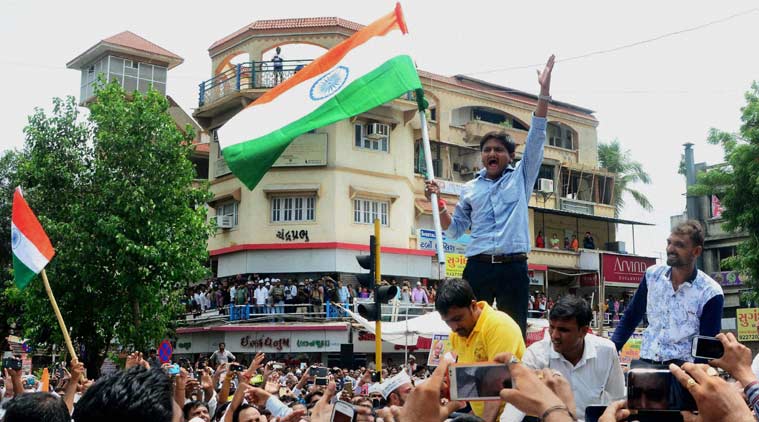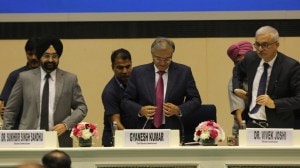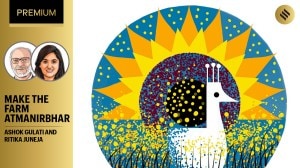Stay updated with the latest - Click here to follow us on Instagram
Sudden Hardik storm rattles state BJP, Patel MLAs duck for cover
The sheer numbers of Patels who turned up for Hardik Patel’s rally in Ahmedabad Tuesday, and the violence that followed his detention, has unnerved the BJP — a party that had got used to the absence of opposition, almost since 2002.
 Patidar community leader Hardik Patel leading a rally for reservation in Ahmedabad on Tuesday. (Source: PTI)
Patidar community leader Hardik Patel leading a rally for reservation in Ahmedabad on Tuesday. (Source: PTI)
On Wednesday, Kumar Kanani, BJP MLA from Varachha in Surat, was to be in Gandhinagar for the monsoon session of the assembly. But he spent all day among his voters, appealing for peace. A Leuva Patidar from Surat, Kanani sounded helpless: “The police are doing nothing, there is curfew in Varachha and still the mobs are out.”
The sheer numbers of Patels who turned up for Hardik Patel’s rally in Ahmedabad Tuesday, and the violence that followed his detention, has unnerved the BJP — a party that had got used to the absence of opposition, almost since 2002.
WATCH VIDEO: Patel Row Turns Violent: Eight Dead, PM Modi Calls For Peace & There’s More Than Meets The Eye
[App users click here to see video]
Ask Kanani about the estimated eight-lakh Patidar turnout for the rally called by Hardik Patel and his Patidar Anamat Andolan Samiti (PAAS), and he says, “Didn’t you see, how he changed the mode of his speech, like we change the mode of our mobile phones.” He was suggesting that Patel’s speech was provocative.
Clearly, this is a wake-up call for the monolith called BJP in Gujarat.
The Patidar agitation for an OBC quota began on July 6, with small rallies in towns dominated by them. The PAAS had successfully mobilised Patels in the age group 18-35 — at a rally in Surat on August 17, an estimated crowd of 4.5 lakh showed up, bringing the city of diamond and textile units to a standstill.
[related-post]
Until then, the BJP’s only rhetoric had been “Hardik is a Congress pawn”.
A BJP functionary, who is not a Patel, had remarked that the BJP had survived several rebellions by Patel titans like Gordhan Zadaphia and Vitthal Radadiya (now BJP MP from Porbandar). On Wednesday, the same functionary said, “This has happened because of the BJP’s policy of Patel appeasement and mollycoddling.”
Zadaphia, a Leuva Patel from Bhavnagar, who was was junior home minister in the Modi government of 2002, had rebelled and launched the Mahagujarat Janata Parishad (MJP). He merged his party with the Gujarat Parivartan Party (GPP) founded by Keshubhai Patel to challenge Modi in the 2012 assembly elections. The GPP won two seats.
The GPP was mainly backed by the RSS and VHP, both Patel dominated bodies. VHP leader Pravin Togadia is also a Leuva Patel. The GPP, however, merged with the BJP before the 2014 Lok Sabha elections, submitting to Modi’s growing national stature.
Before that, there had been Leuva Patidar and Kadva Patidar shows of strength under the aegis of their religious trusts — the Khodaldham and Umiya Mata trusts respectively, named after the deities the two sects follow, in Saurashtra. But these ended with a whimper.
From 2011-14, however, there was another development. The verdicts in the riot cases of 2002, especially in Sardarpura (Mehsana) and Ode (Anand), saw several Patels face conviction and go to jail, following investigation by the Supreme Court-appointed SIT. One prominent face was Babu Bajrangi or Babubhai Patel, a Kadva Patel from Kutch, who faces life imprisonment in the Naroda Patiya massacre case.
The Patels were already feeling betrayed and isolated by their leaders in the government, although Modi, an OBC, never used the caste card till he launched himself in national politics.
On Wednesday, the areas that witnessed violence in Ahmedabad, were the same that had seen communal killings in 2002, and are known to be Patel dominated.
To explain the discontent, a BJP leader said, “There is no connect between the community and the leaders who seemingly represent them in politics.”
The maximum violence was reported from areas falling in the constituencies represented by Chief Minister Anandiben Patel (Ghatlodia), BJP national president Amit Shah (Naranpura), Health Minister and government spokesperson Nitin Patel (Mehsana) — he is also heading the seven-member ministerial panel to sort out the quota issue — and Minister of State for Home Rajnikant Patel (Becharaji).
None was seen talking to the angry community.
Also, ever since Narendra Modi announced his arrival on the Gujarat political stage in 2001, subsequent electoral victories of the BJP were attributed to him. Modi even campaigned for the municipal corporation elections, getting the BJP back in power in all seven corporations.
By 2012, most assembly candidates virtually had no standing. They were simply introduced as candidates from the dais dominated by Modi. In the 2014 Lok Sabha elections too, it was Modi all the way. After his nomination as the prime ministerial candidate, all of Gujarat’s 26 Lok Sabha seats went to the BJP, leaving no opposition.
Zadaphia told The Indian Express, “The Congress cannot even collect 1,500 people, so obviously the 10 lakh crowd that collected (in Ahmedabad Tuesday) is is not a Congress mobilisation. It seems to be spontaneous, maybe a frustration that suddenly exploded. Though Congress adding fuel to this fire cannot be ruled out.”
Blaming the police for the violence, Zadaphia said, “there seems to be lack of a leader who could hold a dialogue with the community, listen to them.”
Congress leader and former Union Minister Shankersinh Vaghela says “the anger was obviously simmering, but so far it was glossed over by the powerful marketing of the leader… now, the veneer is cracking up”.
Asked if the Congress would use this to its advantage, he said, “Politically, we don’t want to get into it.”







